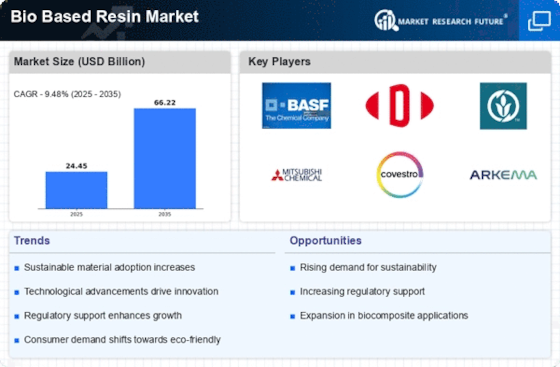Expansion of Application Areas
The Bio Based Resin Market is witnessing an expansion of application areas, which is a key driver of its growth. Industries such as automotive, construction, and consumer goods are increasingly recognizing the benefits of bio-based resins, leading to their integration into a wider range of products. For instance, bio-based resins are being utilized in composite materials, adhesives, and coatings, enhancing their appeal due to their sustainability credentials. Additionally, the versatility of bio-based resins allows for customization to meet specific performance requirements, further broadening their applicability. This diversification is expected to attract new players to the market and stimulate further innovation.
Supportive Regulatory Frameworks
Regulatory support is a significant driver for the Bio Based Resin Market, as governments worldwide implement policies aimed at promoting sustainable materials. Initiatives such as tax incentives, subsidies, and stricter regulations on plastic usage are encouraging manufacturers to explore bio-based alternatives. For example, several countries have established targets for increasing the use of renewable materials in production processes. This regulatory environment not only fosters innovation but also creates a favorable market landscape for bio-based resins. As a result, companies are more inclined to invest in research and development of bio-based products, further propelling the growth of the market.
Rising Demand for Sustainable Materials
The increasing awareness regarding environmental issues has led to a rising demand for sustainable materials in various industries. The Bio Based Resin Market is experiencing significant growth as manufacturers and consumers alike seek alternatives to traditional petroleum-based resins. This shift is driven by the need to reduce carbon footprints and promote eco-friendly practices. According to recent data, the market for bio-based resins is projected to grow at a compound annual growth rate of approximately 12% over the next five years. This trend indicates a robust market potential for bio-based resins, as industries such as automotive, packaging, and construction increasingly adopt these materials to meet sustainability goals.
Innovations in Bio Based Resin Technology
Technological advancements play a crucial role in the evolution of the Bio Based Resin Market. Innovations in production processes and formulations are enhancing the performance characteristics of bio-based resins, making them more competitive with conventional resins. For instance, the development of new catalysts and bio-refining techniques has improved the efficiency of resin production, leading to cost reductions and higher quality products. Furthermore, research indicates that bio-based resins can now achieve comparable mechanical properties to their fossil fuel counterparts, which is likely to attract more manufacturers to switch to these sustainable options. This technological progress is expected to drive market growth and expand applications across various sectors.
Consumer Preference for Eco-Friendly Products
Consumer preferences are shifting towards eco-friendly products, significantly impacting the Bio Based Resin Market. As awareness of environmental issues grows, consumers are increasingly seeking products that align with their values, including those made from renewable resources. This trend is particularly evident in sectors such as packaging, where brands are responding to consumer demand by incorporating bio-based resins into their products. Market Research Future suggests that a substantial percentage of consumers are willing to pay a premium for sustainable options, indicating a lucrative opportunity for manufacturers. This shift in consumer behavior is likely to drive the adoption of bio-based resins across various applications.


















Leave a Comment